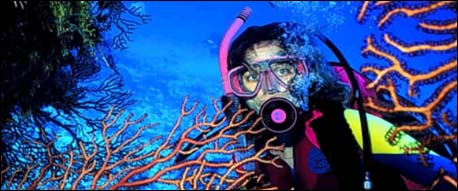
SPONSORED
LINKS
Ocean Facts An Ocean is a great mass of Salt Water that covers the Earths Surface. Our Planet is covered by 71 % water. The Pacific Ocean is the largest Ocean. The Oceans support a wide variety of plants and animals, which co-exist in relative harmony, each
fulfilling the specific niche and role they have in the ecosystem.
We know little of our Oceans than Outer Space!!
Depth: The Ocean floor has varying depths. The Mariana Trench 35,802 ft (10,912 m) is the deepest point on earth. The earth's tallest mountain, Mt. Everest (8,863 m) can be completely sunk in the deep Mariana's Trench in the Western Pacific Ocean!
Life: The Ocean ecosystem is so varied and diverse as compared to the Earths Surface. The existence of life in the Oceans is dependant on the visibility of Light.
Most of the animal life in the ocean is found in three main areas:
-
The SHALLOW BOTTOM near the shores;
-
The SUNLIT SURFACE AREAS of the oceans and seas; and
-
The OPEN OCEAN, just beneath the surface waters.
Light:
In the clearest water at midday, sunlight dims by one-tenth about every 250 feet (75 m). Humans can just barely see light below 1600 feet (500 m), at about one-millionth of the intensity at the surface.
Pressure: Most of the deep ocean is under pressures of 3000 to 9000 pounds per square inch (or about the equivalent of 100 to 300 times the air pressure in automobile tires). The Pressure at the Mariana Trench (deepest point on Earth) is over 8 tons per square inch, or the equivalent of an average-sized woman holding up 48 jumbo jets!
Temperature:
The temperature of almost all of the deep ocean is only a few degrees above freezing,
39F (4C).
Regions
-
The CONTINENTAL SHELF, a shallow margin of the ocean floor between the land and the sea, which is very rich in marine
life
-
The CONTINENTAL SLOPE, where the continental mass ends, and the ocean floor plunges to the true ocean-basin floor; and
-
The OCEAN-BASIN FLOOR, which begins at the foot of the continental slope.
Indian Ocean
Indian Ocean is the third largest of earth's four oceans, (after the Pacific Ocean and Atlantic Ocean, but larger than the Arctic Ocean) which extends from South Asia to Antarctica and from East Africa to South East
Australia.
Area: Total area of the Indian Ocean is 73,427,000 sq km (28,350,000 sq mi). It includes the Arabian Sea, Bay of Bengal, Andaman Sea, Red Sea,Gulf of Oman, Strait of Malacca, Great Australian Bight, Mozambique Channel, and other tributary water bodies which constitutes about 20% of the world's total ocean area.
Depth: The average depth of the Indian Ocean is 3,900 m (12,800 ft), or slightly greater than that of the Atlantic, and the deepest known point is 7,725 m (25,344 ft), off the southern coast of the Indonesian island of Java.
Islands:The Indian Ocean contains numerous islands, the largest of which are Madagascar and Sri Lanka. Smaller islands include the Andaman and Nicobar Islands; the Seychelles and the Kerguelen Islands are exposed tops of submerged ridges. The Lakshadweep
(Laccadives), the Maldives, and the Chagos are low coral islands, and Mauritius and Réunion are high volcanic cones.
Rivers: The Indian Ocean receives the waters of the Zambezi, Tigris-Euphrates, Indus,
Ganges-Brahmaputra, and Irrawady rivers. The surface waters of the ocean are generally warm, although close to Antarctica pack ice and icebergs are found. The southwest monsoon draws moisture from the Indian Ocean and drops heavy rainfall on the Indian subcontinent and Southeast Asia.
Economy: The Indian Ocean provides major sea routes connecting the Middle East, Africa, and East Asia with Europe and the Americas. It carries a particularly heavy traffic of petroleum and petroleum products from the oil fields of the Persian Gulf and Indonesia. Its fish are of great and growing importance to the bordering countries for domestic consumption and export. Fishing fleets from Russia, Japan, Korea, and Taiwan also exploit the Indian Ocean, mainly for shrimp and tuna. An estimated 40% of the world's offshore oil production comes from the Indian Ocean.
OTHER PAGES
7

|